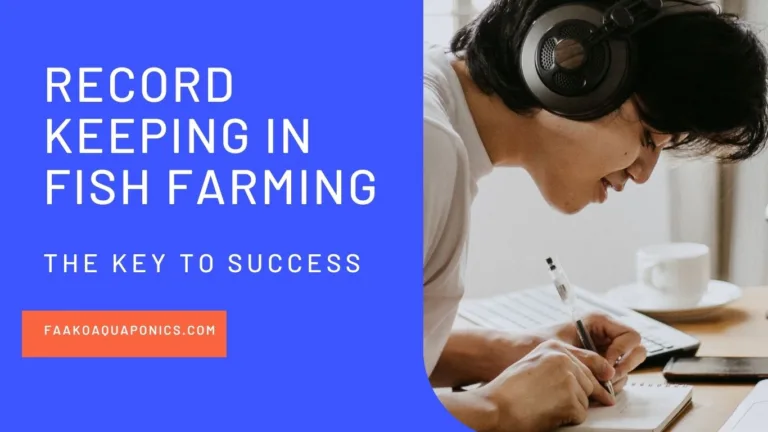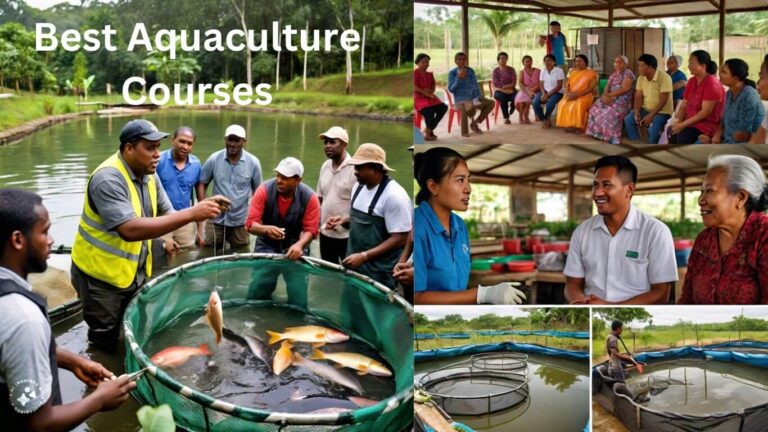Best nets for fish farming are one of the various tools and equipment require to ensure the health and productivity of the fish.
The nets play a crucial role in managing the fish population, protecting them from predators, and maintaining the overall health of the farming environment.
In this blog post, I shall explore the best nets for fish farming, their importance, how to use them effectively, and the advantages and disadvantages of each.
But wait, before I list the various nets and their details, let me make this clarification based on my experience.
Some of the nets can play double role hence you might not be required to get all the nets I have listed. However, it is a must to have some of them based on their importance. As you read the details of the post, you will understand this better by the end. So keep reading.
Scooping Nets
Scooping nets are small, handheld nets designed for the capture of individual fish or small groups of fish. They typically consist of a fine mesh material attached to a frame with a long handle, making them easy to maneuver in tanks and ponds.
Importance of Scooping Nets
Scooping nets are essential for daily fish farm operations. They allow farmers to inspect individual fish for health issues, separate fish for breeding purposes, or transfer fish to different tanks or ponds without causing significant stress or injury. This tool is crucial for maintaining the health and well-being of the fish population.
How to Use Scooping Net
Using a scooping net involves a gentle approach to minimize stress on the fish:
1. Approach the fish slowly: This helps to avoid startling them, which can cause stress and injury.
2. Submerge the net gently: Position the net under the target fish without sudden movements. But sometimes you need to move the net to capture them since they will be running away when they notice it.
3. Lift smoothly: Once the fish is inside the net, lift it carefully to keep the fish secure.
4. Transfer the fish: Move the fish to the desired location gently, ensuring minimal handling to avoid harm.
Advantages of Scooping Nets
– Precision: Allows for targeted capture of individual fish, making it ideal for health inspections and breeding.
– Minimizes stress: The gentle approach reduces stress and potential injury to the fish.
– Versatility: Useful in various scenarios, including transferring fish between tanks or ponds. The scooping nets can again be used to pick out dead fish the ponds surface.
Disadvantages of Scooping Nets
– Labor-intensive: Capturing fish individually can be time-consuming, especially in larger operations.
– Limited capacity: Not suitable for capturing large numbers of fish at once.

Dragging Nets
Dragging nets, also known as seine nets, are large nets designed to capture a significant number of fish simultaneously.
These nets can span several meters in length and are used by dragging them through the water to encircle and capture fish.
Importance of Dragging Nets
Dragging nets are invaluable for harvesting fish or conducting population assessments. They enable farmers to capture large quantities of fish efficiently, saving time and labor compared to individual capture methods.
How to Use Dragging Nets
1. Deploy the net: Place the net at one end of the pond or tank.
2. Drag through the water: Slowly move the net through the water, ensuring it remains submerged and in contact with the bottom to capture fish.
3. Encircle the fish: Once the target area is encircled, pull the ends together to trap the fish.
4. Lift the net: Carefully lift the net out of the water and transfer the captured fish to a holding tank or processing area.
Advantages of Dragging Nets
– Efficiency: Capable of capturing large quantities of fish quickly, reducing labor and time.
– Population management: Useful for conducting population assessments and harvesting.
– Versatility: Suitable for various types of water bodies, including ponds and tanks.
Disadvantages of Dragging Nets
– Potential for injury: The larger scope of the net can cause injury to fish if not handled carefully.
– Requires teamwork: Effective use of large dragging nets often requires a team of people.
– Environmental impact: Can disturb the pond or tank environment, affecting water quality and other aquatic life.
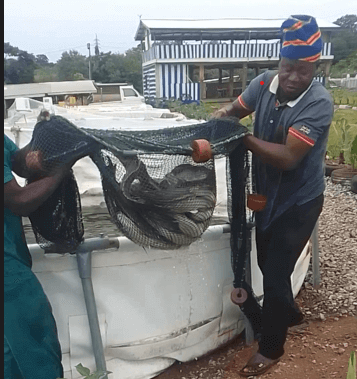
Predator Prevention Nets
Predator prevention nets are heavy-duty nets designed to cover the entire surface of fish ponds or tanks.
These nets are made from robust, UV-resistant materials that can withstand outdoor conditions and deter various predators, including birds, raccoons, and larger fish.
Importance of Predators Prevention Nets
Predator prevention nets are critical for protecting fish from natural predators. By preventing predators from accessing the fish, these nets help maintain the fish population and reduce losses, ensuring a more stable and productive fish farming operation.
How to Use Predators Prevention Nets
1. Measure the area: You need to ensure the net is appropriately sized to cover the pond or tank.
2. Secure the net: Anchor the edges to prevent any gaps where predators could enter.
3. Regular inspection: Check the net regularly for signs of wear or damage, especially after severe weather.
Advantages of Predators Prevention Nets
– Protection: Provides effective protection against a wide range of predators, reducing fish losses.
– Durability: Made from robust materials that can withstand harsh outdoor conditions.
– Cost-effective: Reduces the need for other predator control measures, saving costs in the long run.
Disadvantages of Predators Prevention Nets
– Installation effort: Setting up the net can be labor-intensive and time-consuming.
– Maintenance: You need to constantly regulate and monitor to ensure continued effectiveness.
– Environmental factors: Weather conditions can affect the durability and performance of the net.
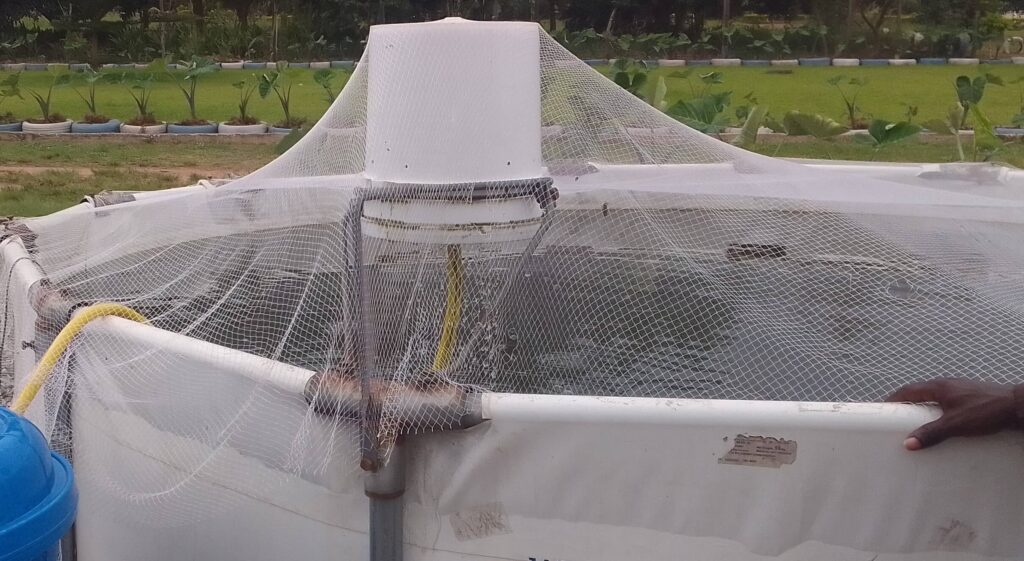
Predator nets to protect fish from predators
Feeding Nets
Feeding nets are specialized nets used to distribute feed evenly across the fish farming area. These nets often come with adjustable mesh sizes to control the amount of feed released, ensuring that all fish have equal access to food. The feeding net must be in your fish farm from day one because its good for handling fingerling as well.
Importance of Feeding Nets
Feeding nets ensure that all fish have equal access to food, promoting uniform growth and reducing competition among fish. Proper feeding techniques can enhance the overall health and productivity of the fish farm.
How to Use Feeding Nets
1. Fill the net: Place the appropriate amount of feed into the net.
2. Distribute the feed: Submerge the net slightly and move it gently across the water to release the feed evenly.
3. Adjust mesh size: Modify the mesh size as needed to control the release rate of the feed.
4. Remove Uneaten Feed: The feeding nets are also used to remove the uneaten or left over feed on the surface of the fish pond. And also insoluble particles in the pond. This is especially true if you are feeding your fish with the floating pelleted feed.
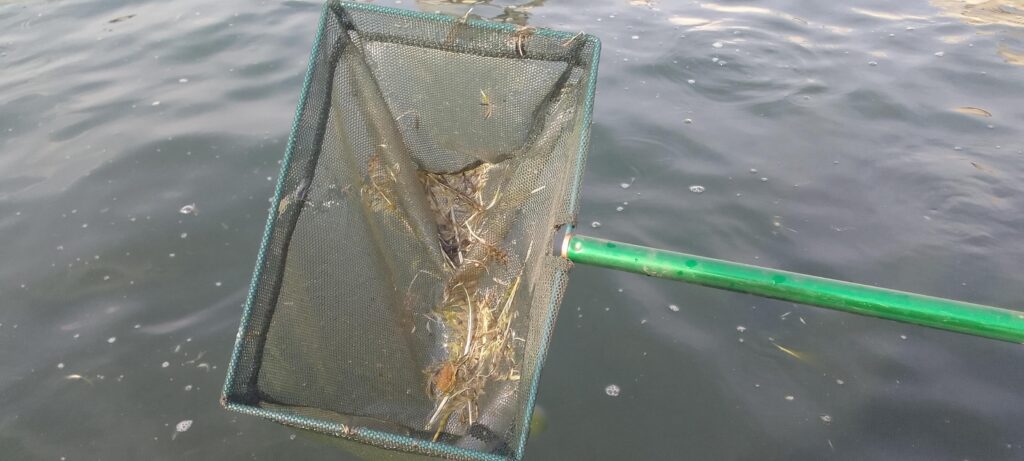
Harvesting net used to harvest insoluble particles
Advantages of Feeding Nets
– Uniform feeding: Ensures all fish receive adequate food, promoting balanced growth.
– Reduces waste: Controlled release of feed minimizes waste and prevents overfeeding.
– Improves water quality: By reducing feed waste, water quality is maintained, benefiting fish health.
Disadvantages of Feeding Nets
– Initial cost: Purchasing specialized feeding nets can be an additional expense.
– Learning curve: Farmers may need time to learn how to use the nets effectively for optimal feed distribution.
– Maintenance: You would have to clean up the net to prevent the buildup of old feed, which can harbor bacteria.
Sorting Nets
Sorting nets are used to separate fish by size, species, or health status. These nets typically feature compartments or varying mesh sizes to facilitate the sorting process, making them essential for managing fish populations effectively.
Please note that, you can use the scooping net or the dragging net to do sorting depending on the scale of the farm. If it’s a small farm, then use a scooping net but if its a large farm, then use a dragging net.
Importance Sorting Nets
Sorting nets help manage fish populations more effectively, allowing farmers to segregate fish for breeding, growth optimization, or medical treatment. This sorting process can enhance the overall health and efficiency of the fish farm.
How to Use Sorting Nets
1. Deploy the net: Place the sorting net in a holding tank or pond.
2. Capture fish: Use a scooping net or similar tool to place fish into the sorting net.
3. Sort the fish: Allow fish to move through the compartments, where they will be sorted based on size or other criteria.
4. Transfer sorted fish: Move sorted fish to the appropriate tanks or ponds for further care or growth.
Advantages of Sorting Nets
– Population control: Helps manage fish populations by size and health status, promoting optimal growth conditions.
– Health monitoring: Enables regular health checks and segregation of sick or injured fish.
– Breeding management: Facilitates selective breeding by allowing easy separation of fish by species or size.
Disadvantages Sorting Net
– Stress on fish: The sorting process can cause stress, especially if not done gently.
– Labor-intensive: Requires careful handling and attention to detail, making it labor-intensive.
– Potential injury: Mishandling during sorting can lead to injuries or fatalities among fish.

The scooping net can also be used for sorting
Harvesting Nets
Harvesting nets are designed for the final capture of fish when they are ready for market. These nets are typically large and durable, capable of handling significant loads without tearing, ensuring the efficient and safe collection of fish.
Importance of Harvesting Nets
Harvesting nets are crucial for the efficient and safe collection of fish at the end of the growth cycle. They ensure that fish are harvested quickly and with minimal stress, preserving their quality for market sale.
How to Use Harvesting Nets
1. Deploy the net: Place the harvesting net in the pond or tank.
2. Corral the fish: Slowly gather the fish into a smaller area using the net.
3. Lift the net: Carefully lift the net to avoid injuring the fish.
4. Transfer the fish: Move the harvested fish to holding tanks or transport containers.
Advantages Harvesting Nets
– Efficiency: Allows for quick and large-scale harvesting, saving time and labor.
– Quality preservation: Minimizes stress and injury to fish, maintaining their quality for market.
– Durability: Made from strong materials, ensuring longevity and reliability.
Disadvantages of Harvesting Nets
– Requires manpower: Effective use of large harvesting nets often requires a team.
– Potential stress: Despite careful handling, the harvesting process can be stressful for fish.
– Environmental impact: Can disturb the pond or tank environment, potentially affecting water quality.

Conclusion
In conclusion, using the best nets for fish farming is essential for the successful management and productivity of a fish farm.
Each type of net serves a specific purpose, from daily maintenance to final harvesting, and using them correctly can significantly enhance the efficiency and sustainability of your fish farming operation.
By understanding the importance, advantages, and disadvantages of scooping nets, dragging nets, predator prevention nets, feeding nets, sorting nets, and harvesting nets, you can ensure the health and growth of your fish population while optimizing your farming practices
Recommendations
Per my personal experience, I recommend you get these down before you finally need any of them. Remember the popular Maxim that “You cannot pick and train a dog on the hunting day”. The earlier you have them and get used to them, the better.
I have carefully selected and listed them on Amazon for you. Just click on the above links to each of the nets and make your purchase.
If You cannot get all these nets, for my personal experience, you must get these four (4) nets. These nets can solve all the problems. The Feeding Net, Scooping Net, Dragging Net, and Predator Prevention Net.
Thank You.




